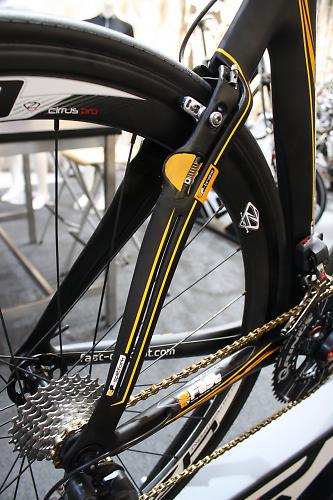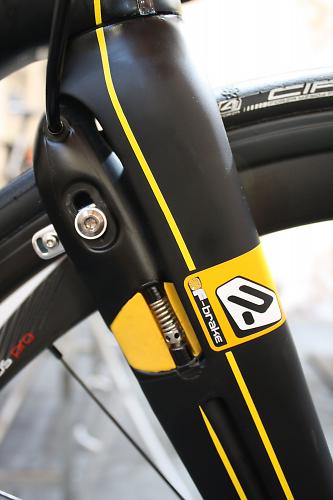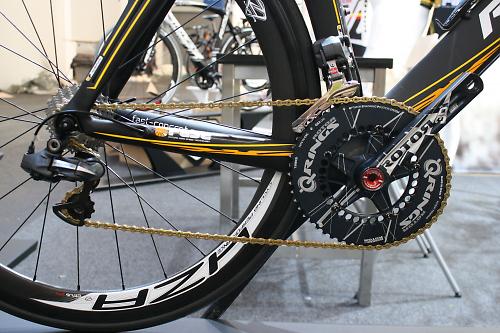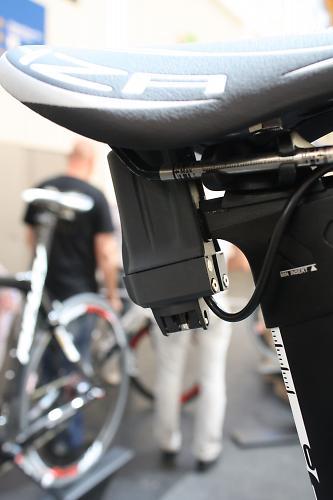- News
- Reviews
- Bikes
- Components
- Bar tape & grips
- Bottom brackets
- Brake & gear cables
- Brake & STI levers
- Brake pads & spares
- Brakes
- Cassettes & freewheels
- Chains
- Chainsets & chainrings
- Derailleurs - front
- Derailleurs - rear
- Forks
- Gear levers & shifters
- Groupsets
- Handlebars & extensions
- Headsets
- Hubs
- Inner tubes
- Pedals
- Quick releases & skewers
- Saddles
- Seatposts
- Stems
- Wheels
- Tyres
- Tubeless valves
- Accessories
- Accessories - misc
- Computer mounts
- Bags
- Bar ends
- Bike bags & cases
- Bottle cages
- Bottles
- Cameras
- Car racks
- Child seats
- Computers
- Glasses
- GPS units
- Helmets
- Lights - front
- Lights - rear
- Lights - sets
- Locks
- Mirrors
- Mudguards
- Racks
- Pumps & CO2 inflators
- Puncture kits
- Reflectives
- Smart watches
- Stands and racks
- Trailers
- Clothing
- Health, fitness and nutrition
- Tools and workshop
- Miscellaneous
- Buyers Guides
- Features
- Forum
- Recommends
- Podcast
TECH NEWS
Eurobike 2011: XXX road bike porn
We're out of Eurobike in a few hours so we're on a mission to sling as many pics of 2012 bikes your way before we go. So, here we go with some more road bike filth...
Ridley are shouting loudly about what they’re calling their Fast Concept which is essentially a name for some of their existing aerodynamics technology along with a brand spanking new integrated brake.
Fast stands for Future Aero Speed Technology – which is pretty good as contrived acronyms go. The really new feature is the F-Brake.
It’s pretty difficult to get the idea of what’s going on here just by looking at the picture so think of it like this: it’s a cantilever brake with the arms built into the fork and the seatstays. The arms are part of the fork/seatstay and it works like a V-brake, the cable reaching across the top causing the arms to pivot together when it’s pulled. Ridley are calling it “the first brake that makes you faster” – in a reducing drag kind of a way.

The Fast Concept also envelops the F-Splitfork – where each leg of the fork is… well, split – two legs for the price of one with a tiny gap down the middle. The idea is that it draws air away from the spokes and counteracts turbulence generated by the wheels.

The final prong is the F-Surface which, like the Splitfork technology, Ridley have been using for a while already. They apply narrow textured surfaces on various sections of the frame to influence airflow – allowing the air to travel smoothly around the frame rather than creating drag.
Various bikes in the Ridley range feature different Fast Concept technologies. The Noah top end road bike and the time trial equivalent, the Dean, gets the lot.

Ridley reckon the F-Brake reduces turbulence and drag by 4.3%, the extended F-Splitfork reduces drag by up to 8.2%, and the F-Surface paint technology reduces drag by 4.1% over components that don’t have these technologies. They claim this offers up to a 2.8km/h advantage and up to 20 watts less power input needed to average a 40km/h (25mph) breakaway.

On the Di2 version, Ridley squirrel the battery away underneath the saddle to stop it affecting airflow over the frame.

Specialized launched their light, stiff and aero Venge much earlier in the year but here’s another look. This is Mark Cavendish’s model. That Pro Vibe stem at the front is huge, holding things steady when the Manx lad gets busy in the sprints.

We looked at the S-Works Project Black McLaren SL4 back at the Tour de France too. This is Alexandre Vinokourov’s bike and it looks pretty darn sleek… and undamaged.

This is Fuji’s high-modulus carbon Grand Fondo which is, as the name suggests, a lightweight, all-day mile muncher for the sportive crowd with an emphasis on comfort. The taller than standard head tube creates a slightly more upright riding position and the frame is designed to be compliant to help stave off fatigue. The lower headset bearing is 1 ½in and the cabling is internal.

This 2.0 version comes with a mainly Shimano Ultegra groupset and Oval 330 wheels.

The 3.0 is made from a lower gradeof carbon but the geometry is the same. It has a Shimano 105 group and the same Oval wheels.

The Newest is Fuji’s value drop-bar series. The bikes come with alloy frames, carbon forks, relaxed geometry, and triple chainsets throughout.

Fuji have a Classic Track Steel bike and now they’ve added this new one, the Classic Track Alloy.

They use identical geometry/spec – it’s just the frame material that’s different. This new model should offer a sizable weight saving and increased stiffness.

This is Litespeed’s new weight-focussed L1R. Like the other two L Series bikes, it’s described as ‘semi-aero’. How do they justify the tag when the tube profiling doesn’t look particularly aero? The bottom bracket shell is asymmetric and the down tube is offset by 18mm which is designed to divert airflow to the cleaner non-driveside of the bike. That’s technology borrowed from Litespeed’s sister tri company, Quintana Roo.

The BB is the new 386 standard and L Series will be available in Ultegra Di2 and mechanical Ultegra options as well as this Campagnolo Super Record build.

Check out the tubes on this Velo Vuelo. Basically, the top tube and down tube twist along their lengths. Why? Sorry, we were unable to find out what the reasoning is although Lynskey do a Helix with spiral tubes and they reckon it adds stiffness. We’ve never used it so we couldn’t tell you if it works.

Maybe it’s just designed to attract attention… in which case we fell right into their trap, goddamit it. If you’re wondering where the back brake is, by the way, they’ve slung it underneath the bottom bracket in a time trial stylee. (No funnies necessary about the ‘Shocker’ stand; that’s the name of the German distributor).

Here’s the Basso Diamante and we’ve slung it in because it looks pretty striking. The Diamante is the top road model from the Italian brand.

The lower headset bearing is a super-wide 1 1/2in and the rear brake cable runs internally although the gear cables stay outside.
Mat has been in cycling media since 1996, on titles including BikeRadar, Total Bike, Total Mountain Bike, What Mountain Bike and Mountain Biking UK, and he has been editor of 220 Triathlon and Cycling Plus. Mat has been road.cc technical editor for over a decade, testing bikes, fettling the latest kit, and trying out the most up-to-the-minute clothing. He has won his category in Ironman UK 70.3 and finished on the podium in both marathons he has run. Mat is a Cambridge graduate who did a post-grad in magazine journalism, and he is a winner of the Cycling Media Award for Specialist Online Writer. Now over 50, he's riding road and gravel bikes most days for fun and fitness rather than training for competitions.
Latest Comments
- chrisonabike 7 min 50 sec ago
This chap needs to go back for a physics refresher. Is traffic an incompressible fluid ("it will just go elsewhere") or not ("there will be more...
- tony.westclassics@live.co.uk 13 min 1 sec ago
I remember when my dad got my first bike for £20 guineas, a million years ago, thats how old I am
- tony.westclassics@live.co.uk 23 min 47 sec ago
All these wheels in part are maufactured in Far East, maybe not the hub, but the rim, so why buy just to get thier name on them, ive just purchased...
- David9694 47 min 50 sec ago
“Car is king” I’m often told, but it appears to be scared of gaining new subjects....
- matthewn5 51 min 3 sec ago
Yeah +1 for geometrygeeks, it's the best way to work out whether a bargain bike frame will actually fit you. Surprising how reach can vary with...
- Steve K 53 min 51 sec ago
We support cycle lanes - ...
- chrisonabike 1 hour 13 min ago
Sounds counterintuitive but I think fixing the legal system would be harder than fixing the street design and rules - and might even cost more!...
- aramaerospace 4 hours 54 min ago
Increased drive friction and power loss:...
- Geoff H 7 hours 1 min ago
I was really enjoying the article until I came to the price!
- OldRidgeback 7 hours 54 min ago
I have a very old MTB (guess what make) that I'll happily leave locked at the train station or shops or whatever. The fairly new Trek MTB or...




































































































Add new comment
2 comments
Phwoooar! for the Noah!
I like the sound of what Ridley claims for their aerodynamics, but as an aeronautical engineer and glider pilot, just a little bit of me is sceptical.